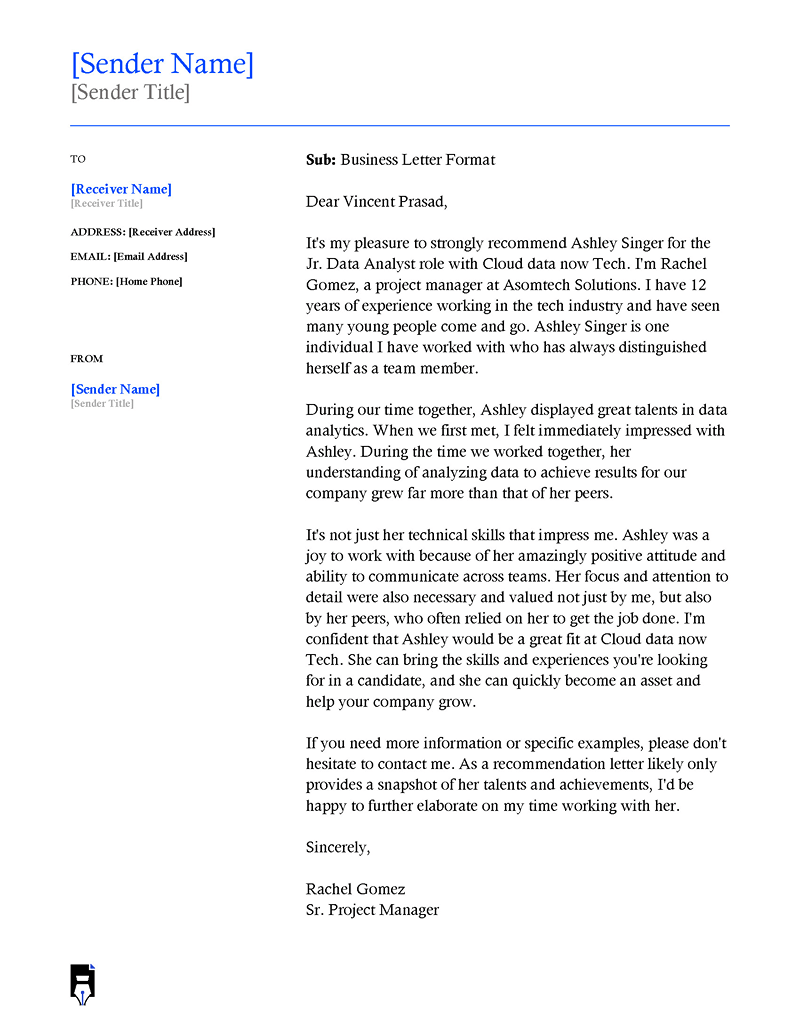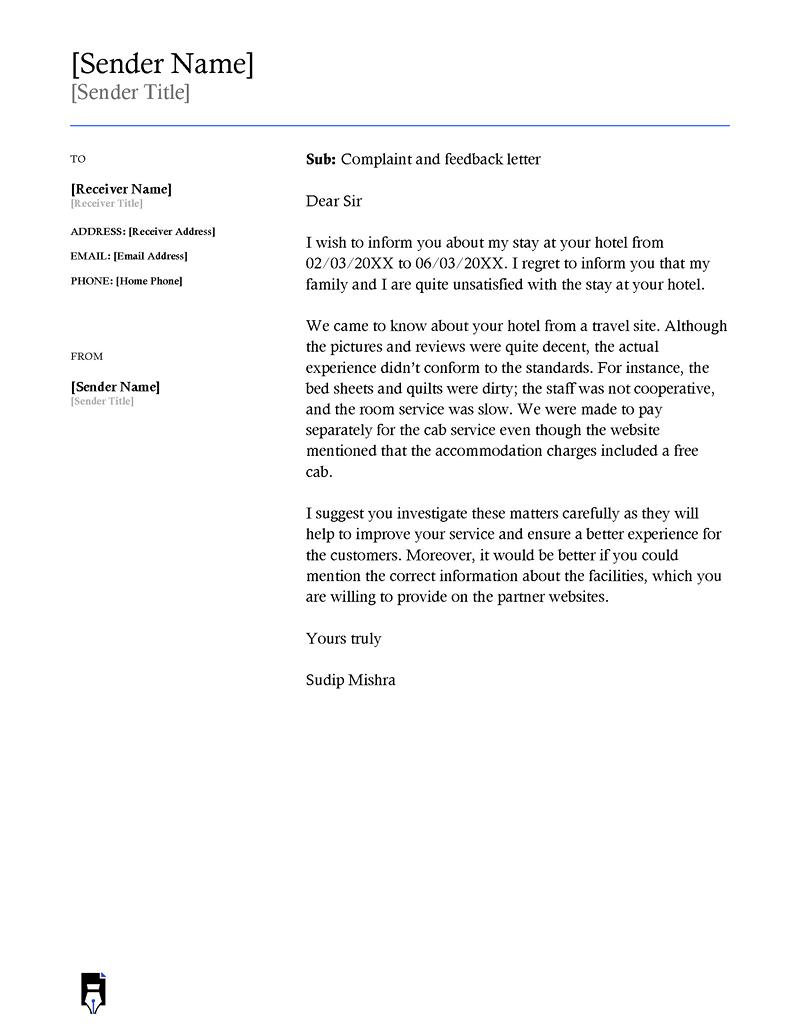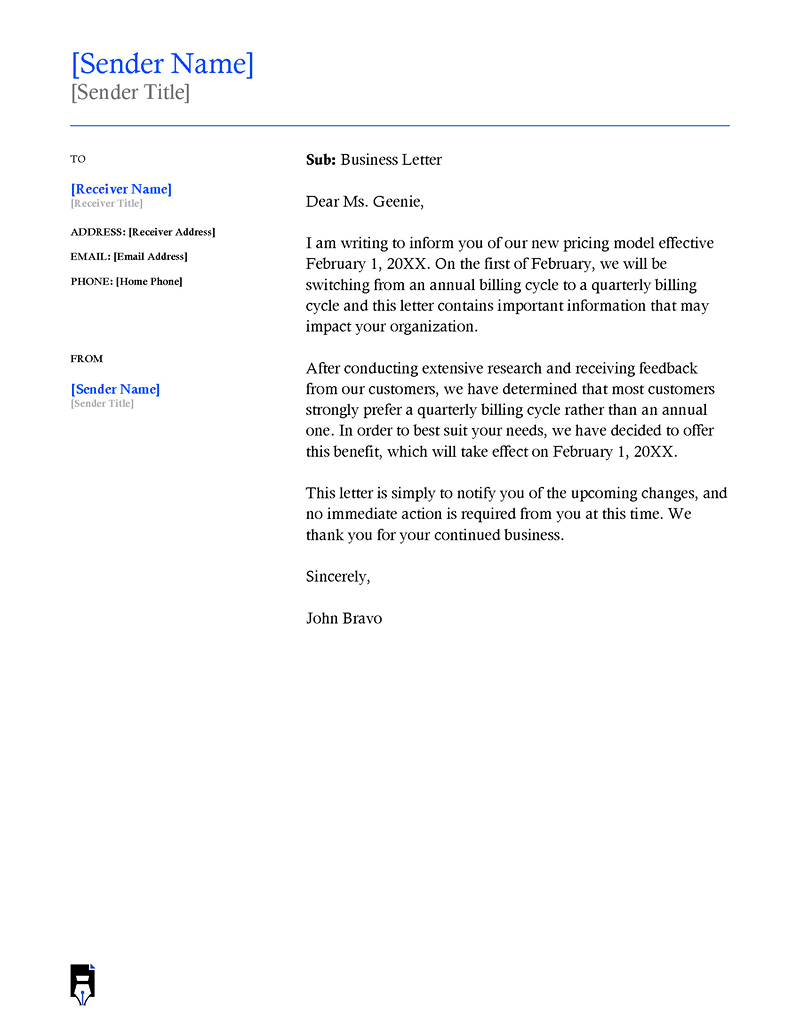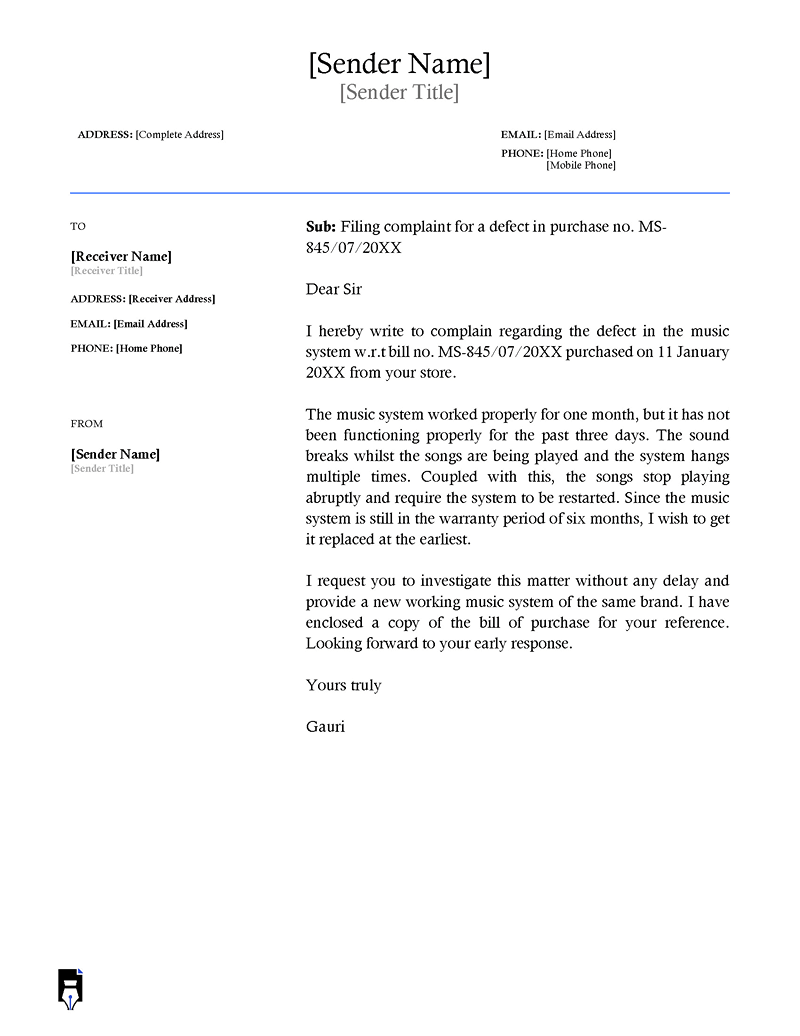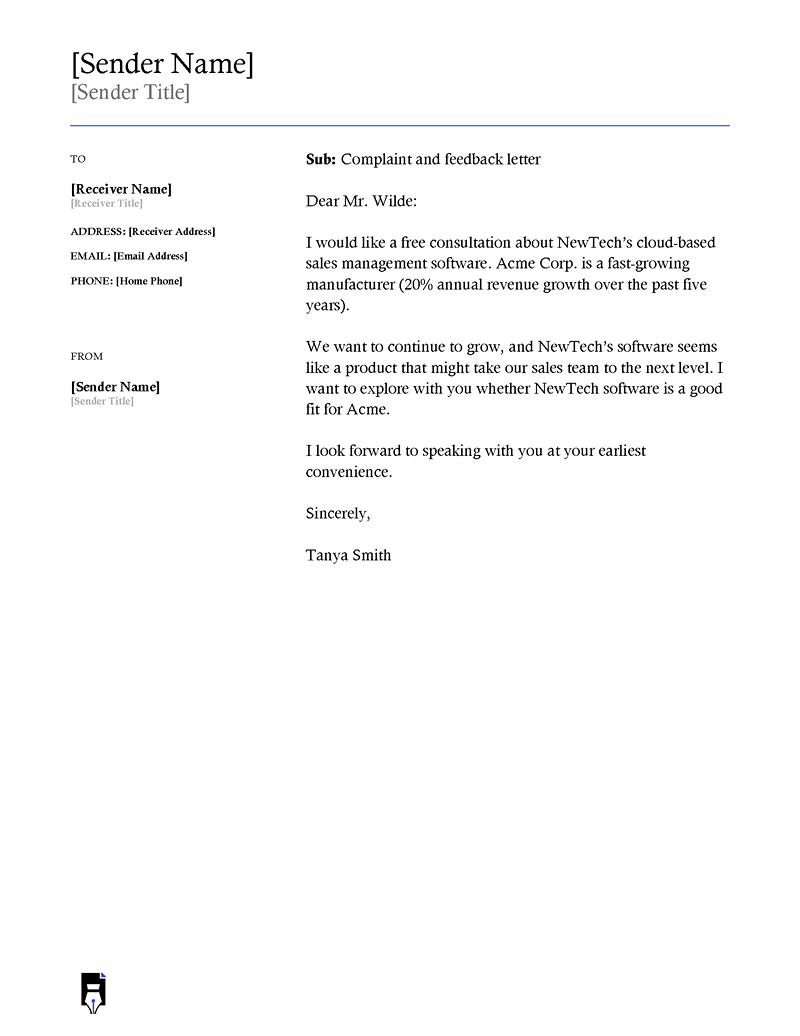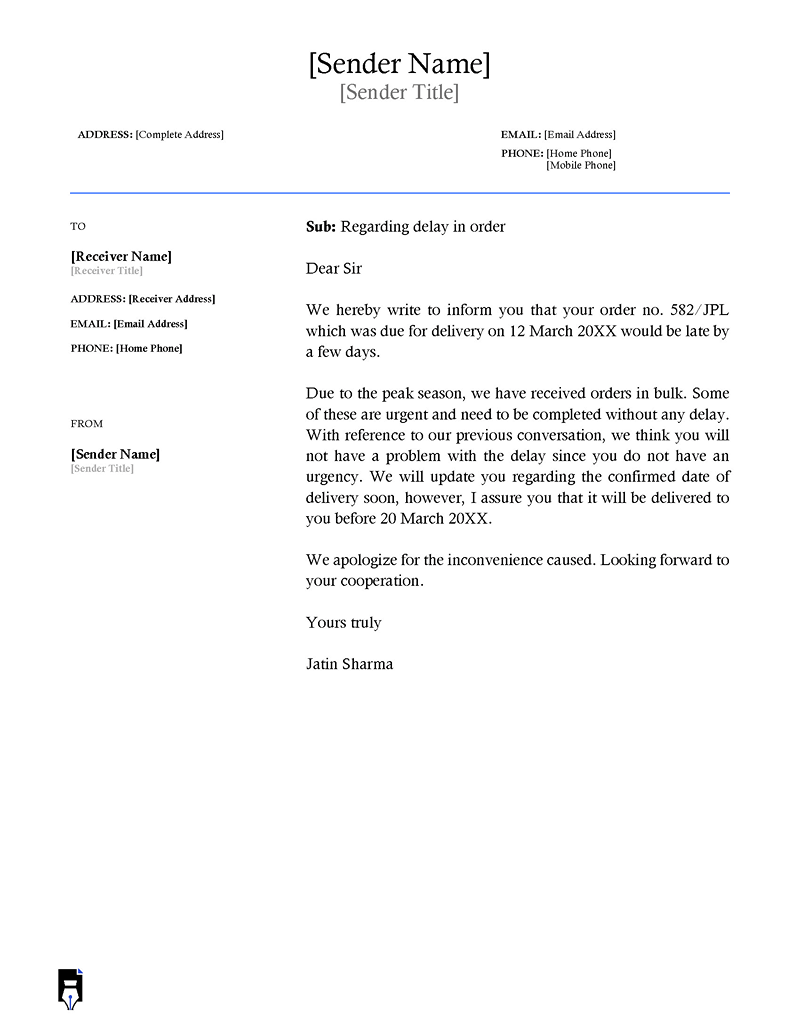Letters are still the most common form of correspondence in business due to their effectiveness in delivering information. Though slower than other types of communication like emails, they are still reliable, especially when records have to be maintained. They can be used for internal correspondence between colleagues, departments, or franchises to issue memos, notices, news, etc.
For external correspondence, letters are used to communicate between businesses, clients, banks, government agencies, and suppliers. As a result, there are multiple types of letters in any professional setting, such as recommendations, cover letters, invitations, complaints, business invitations, resignation letters, etc. Due to the importance of such correspondence, it is vital to ensure that the letters are well-written, properly formatted, and structured to reflect the professionalism of the business. To achieve this, businesses must understand the different components of formal letters.
A business letter is fundamentally a formal type of communication tool used to share information, ideas, news, thoughts, and opinions between businesses or professionals. It can be written between stakeholders, business partners, employees, clients, etc. It will typically showcase the sender, recipient, salutation/greeting, the message being conveyed, and closing or signing off.
This article discusses the importance of letters in business while outlining who can send them. It also emphasizes the impact of well-written business correspondence and provides samples and tips illustrating the correct format and essential components to include in such letters.
Business Letter Templates
You can download the following templates for free:
Who Uses Business Letters
The letters can be from business-business, business-consumer, company-employee, staff-staff, company-job applicant, or any other scenario where official communication is needed.
Examples of those who may write such letters include:
Professionals
Professionals in different industries will typically have to write business correspondence to address different matters in their line of work. Examples of industries where formal letters are common include law, finance, healthcare, marketing, governance, legislation, and mass communication.
Business owners and entrepreneurs
Business owners need formal correspondence to interact with stakeholders, board members, staff members, clients, investors, and government agencies. This is why it is highly important to have proper business documentation. Such letters can be used to pitch ideas to investors, notify stakeholders on important issues, communicate news to staff members, or write job proposals.
Job applicants
Cover letters are popular examples of business letters. Job seekers use them to persuade employers to interview them and offer them job opportunities. Job seekers are also known to write inquiry letters to learn about job openings and thank you letters to thank employers after the hiring process.
Students and academics
Students write such formal communications as part of their coursework or while communicating with professors and administration offices in the school. Academics use formal correspondence when seeking permits and consulting with professionals during research.
The Impact of Well-Written Business Letters
Businesses use letters for different reasons, whether to persuade, inform, request, recommend, propose an idea, thank, remind, congratulate, follow up, invite, or formalize decisions. The effectiveness of the letter in achieving its intended objective depends on whether it is properly written.
The following are the impacts of well-crafted correspondence in a professional setting:
Establishes credibility and professionalism
Typically, a physical letter is deemed more credible and professional than an email or text. This is because crafting a quality letter takes time and thus indicates the sender’s legitimate intentions to convey the respective message. Also, elements such as a business logo and company letterhead can be used as further affirmation that the sender attests to the letter’s contents.
Communicates important information
Most businesses and people understand that written communication is meant for highly important information and will thus prioritize it among other types of correspondence. So, it is a convenient way of ensuring that urgent and vital matters are conveyed between businesses and individuals.
Builds and maintains relationships
Letters in business ought to be courteous and accurate and use a formal tone. These are elements that can create and maintain new and existing business relationships.
Creates a paper trail
Written communication can be preserved as part of company records. A properly crafted letter ought to be factually accurate. This is so that the document can be used as evidence of transactions, agreements, and events between businesses or individuals.
Demonstrates attention to detail and good writing skills
The formatting rules for high-quality business correspondence should be followed, and the writing should be clear and presentable. So, if these aspects are adhered to, the document illustrates the sender’s exceptional writing skills and ability to pay attention to details.
Formal Letter Formats
A business letter can have different formats. Each format will have different specifications that influence the layout of the letter. Also, the formats have distinct purposes. Here are the three commonly used formats:
Full block format
All text aligns to the left in this format. This includes the sender’s address, date, recipient address, greeting, body, complimentary close, and signature, all separated using double space except for the body paragraphs. The paragraphs are not indented but are separated by a single line space.
Semi-block format
A semi-block format left aligns all text, similar to a full-block format. However, the first line of every paragraph is indented.
Modified block format
The modified block form is the same as the full block form, except the sender’s address is right-aligned.
Elements of a Formal Letter
When writing a formal business letter, it is important to include all necessary components to ensure clarity and professionalism. The specific components of a business letter can vary depending on the purpose and format of the letter but typically include the sender’s address, date, recipient’s address, salutation, body, closing, and signature block.
Additional components, such as a reference line or enclosure notation, may also be included as needed. Understanding the components of a formal business letter and how to arrange them properly can help ensure that your message is clear, concise, and professional.
A properly formatted letter of business will typically have the following elements in its layout.
Sender’s information
The sender’s information is written at the top of the document. It is necessary to let the recipient know who sent the letter. This section contains the business’s name, address (city, state, zip code), valid phone number, and email address. The name of the author may also be included.
Pro-tip: A letterhead is premade to outline this information. So, the company letterhead can be used to save time instead of manually typing this information.
Date
All written correspondence has to be dated, and a business letter is no exception. This is typically the date when the document was prepared. It should be in the correct format, according to the country and the preferences of the organization, and with no abbreviations.
For example:
Month Day, Year (e.g., January 1, 2023), Day Month Year (e.g., 1, 2023), or Year Month Day (e.g., 2023-01-01).
It is important to use a consistent date format throughout your correspondence to avoid any confusion or misinterpretation.
Recipient’s address
It must be clear who the intended recipient of the letter is. Details that should be provided in this section are the recipient’s name, title, affiliated company name, and company address (city, state, and zip code). Note that appropriate titles such as Dr., Eng., Mr., and Ms./Mrs. can also be used. However, always verify to avoid using inappropriate or incorrect titles.
Greeting
Greetings or salutations are mandatory in any formal communication. The most suitable format for a generic formal salutation is Dear + [title] + [last name]—e.g., Dear Mr. Ford. The format Dear + [first name] is also permitted, but only if there is an informal relationship with the recipient. Also, when the recipient’s gender is unknown, it is advisable to use their full name, e.g., “Dear Kerry Miles.” Lastly, use a colon (:) to close the salutation, not a comma.
Pro-tip: Avoid using the salutation “To Whom It May Concern.” The name of the correct addressee can be found by conducting research, if necessary.
Body paragraphs
The body outlines the message or information being conveyed in detail. It can be categorized into an opening statement, a main argument, and a conclusion. The opening introduces the sender and the topic or purpose of the letter. It should only be a few sentences long, as its purpose is to give the reader an overview of the letter and compel them to continue reading.
The main argument contains detailed information regarding the subject of discussion. This section answers queries, raises questions, gives examples, and states facts needed to achieve the objective of the correspondence. A precise conclusion must then be provided to summarize the key points of the message.
Pro-tip: Single-spaced text is appropriate for the body paragraphs, and a single space should be used to separate each section.
Closing
A closing section is used to express gratitude or include a CTA (call to action) that provides details regarding the next steps to be taken by either party. It should be brief—at most two sentences. It should be followed by a complimentary phrase such as “sincerely,” “best regards,” “respectfully,” “yours sincerely,” etc.
Signature
The signature block typically includes the sender’s full name, their job title or position within the company, and their signature. This component serves as a formal way of signing off on the letter and can also provide the recipient with additional information about the sender’s role and authority within the organization. The signature block is usually placed below the closing phrase and can be either typed or handwritten, depending on the sender’s preference.
Enclosures
Enclosures are any supporting documents sent along with the letter. This is optional and dependent on the situation at hand. Type the word “Enclosure(s):” followed by a list of the documents. An example of an enclosure is a resume attached to a cover letter.
Copy circulation
Copy circulation, abbreviated as CC is a directive used to indicate any additional recipients of the letter. This option is essential when businesses want to send the same communication to multiple people in the same organization.
Postscript
Abbreviated as “PS,” it is any additional information or message that had to be communicated after the letter was completed. The abbreviation (P.S.) must be written before the text and must be capitalized. This element can be essential as an important afterthought that can be added to the letter without having to rewrite the entire letter.
Samples of Business Letters
Two business letter samples are given below:
Cover letter sample
John Dario
Brickwood Estate Road
Phoenix, AZ 3002
March 20, 2023
Chris Redmond
HR Manager
Venture Realtors
Industrial Park Street
Scottsdale, AZ 3002
Dear Mr. Redmond:
I am interested in the Chief Strategy Officer position at Venture Realtors. I learned of the opportunity through your monthly newsletter. I have been a strategic manager for the last 5 years, and I believe I can increase your firm’s market share in the rental sector. I am a firm believer in functional and affordable housing, which is something you excel at.
In my previous employment, I developed and oversaw the implementation of marketing and resource optimization strategies that saw the company’s market share rise from 20% to 40% in the city’s urban market. I oversaw a team of 30 members and utilized my project management skills to ensure tasks were completed before deadlines. I have also worked as a sales executive and managed to sell residential properties with a combined worth of $200 million. I am a social person who believes in investing in talent in order to increase productivity in the workplace. As such, I believe I am qualified to lead the docket and be part of your company’s vision to be a leading regional property management firm.
I will be a valuable asset to Venture Realtors if given the opportunity. I intend to bring my vast experience in real estate, sales, and property management on board. I hope to be considered for the position. I would be happy to follow up with you to discuss my application further. Please let me know if there is any additional information you need from me or if you would like to schedule a phone call or meeting. You can contact me from Monday to Friday between 8:00 a.m. and 4:00 p.m. I look forward to hearing from you soon.
Yours Sincerely,
John Dario
[Signature]
Enclosure: Resume
Letter of resignation
Chloe Barker
Sundown Street
Seattle, WA 88004
March 20, 2023
David Schulz
Human Resource Manager
M&Greer Finance Solutions
Ridgewood Avenue,
Columbia, WA 88004
Dear Mr. David Schulz:
This letter is to notify you that, unfortunately, I will resign from my position as a systems diagnostics analyst at M&Greer Finance Solutions. This resignation will be effective as of April 1, 2023.
I have been offered a senior position at another company and plan to take it in order to challenge myself at a higher level. It has been an incredible journey working at your company. I have learned the importance of inclusivity, collaboration, and teamwork in achieving organizational goals. The support from the entire community has been overwhelming throughout my tenure, and I will be eternally grateful for this opportunity. I will be returning all company property before I leave. Also, I will assist my successor if needed to ensure they are adequately assimilated into the role. I do hope to receive my severance package and bonus checks before leaving.
I appreciate your guidance and personal and professional support. I wish the entire firm continued prosperity and hope we can interact again in the future.
Thank You.
Sincerely,
[Signature]
Chloe Barker
Systems Diagnostics Analyst
Writing Business Letters: Dos and Don’ts
As discussed earlier, the importance of a professionally written letter cannot be overstated in business. While it may take time to perfect the writing skills needed to create exceptional formal written correspondence, it is doable after understanding what practices to adopt and avoid.
Below are the dos and don’ts when writing a business letter:
Do’s
Be concise
The letter ought to be a page long at most. This is often enough to convey any message effectively. Also, brief letters have a higher chance of being read in their entirety. They also demonstrate the sender’s respect for the reader’s time.
Did you know? According to texting experts, only 20% of emails are opened, and most are lost or deleted immediately. Also, 95% of messages are read within 3 minutes. So, written correspondence remains a preferred form of communication in business. Businesses have been reported to share information using both email and print and send a shorter message than text to ascertain that the information was received.
Use a professional font
Use a formal font such as Times New Roman, Arial, or Calibri. Also, use standard font size, preferably 12 points, but it can be adjusted between 10-12 points to keep the length of the letter to one page.
Pay attention to the spacing and margins
The text should be single-spaced. However, paragraphs should be separated by double spaces. Use standard margins of 1 inch on all sides.
Proofread
Proofreading is mandatory when writing formal correspondence. Identify any grammatical, punctuation, or spelling errors and correct them. Letters that contain such errors will most likely be dismissed and indicate a lack of professionalism.
Did you know? Grammar, spelling, and punctuation errors are the most common types of errors in formal communication, according to Grammarly. This further shows the need to proofread to avoid such errors.
Don’ts
Using informal language
Business correspondence should only use formal language. Avoid using informal abbreviations, names, catchphrases, or jargon.
Using contractions
Avoid using contractions, which are the shortening of phrases by merging two words. Examples of contractions are you’re, didn’t, can’t, etc. They are considered informal.
Don’t use jargon or technical terms
While it is important to demonstrate your expertise, using industry-specific jargon or technical terms can make your letter difficult to understand for those outside your field.
Don’t be overly negative or critical
Even if you have a complaint or issue to address, it is important to maintain a professional tone and avoid using overly negative or critical language.
Final Thoughts
Learning how to craft a professional letter is important. Even though there are multiple communication channels and tools, written correspondence remains the preferred means of conveying important information in business. The basic layout of a business letter includes the sender’s details, date, recipient’s details, greeting, body, closing, and signature. It is advisable to review samples to learn how to write business correspondence properly.
